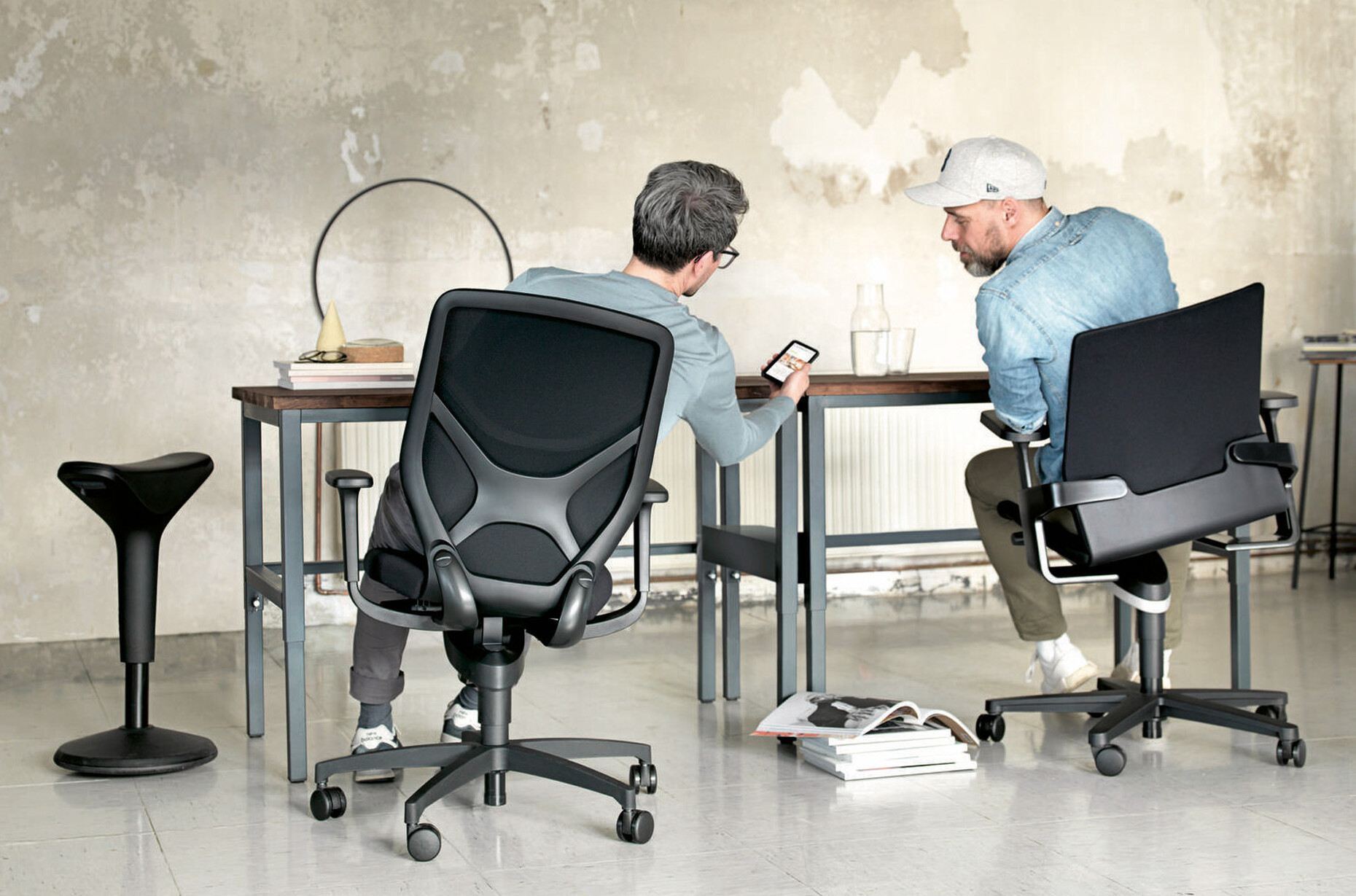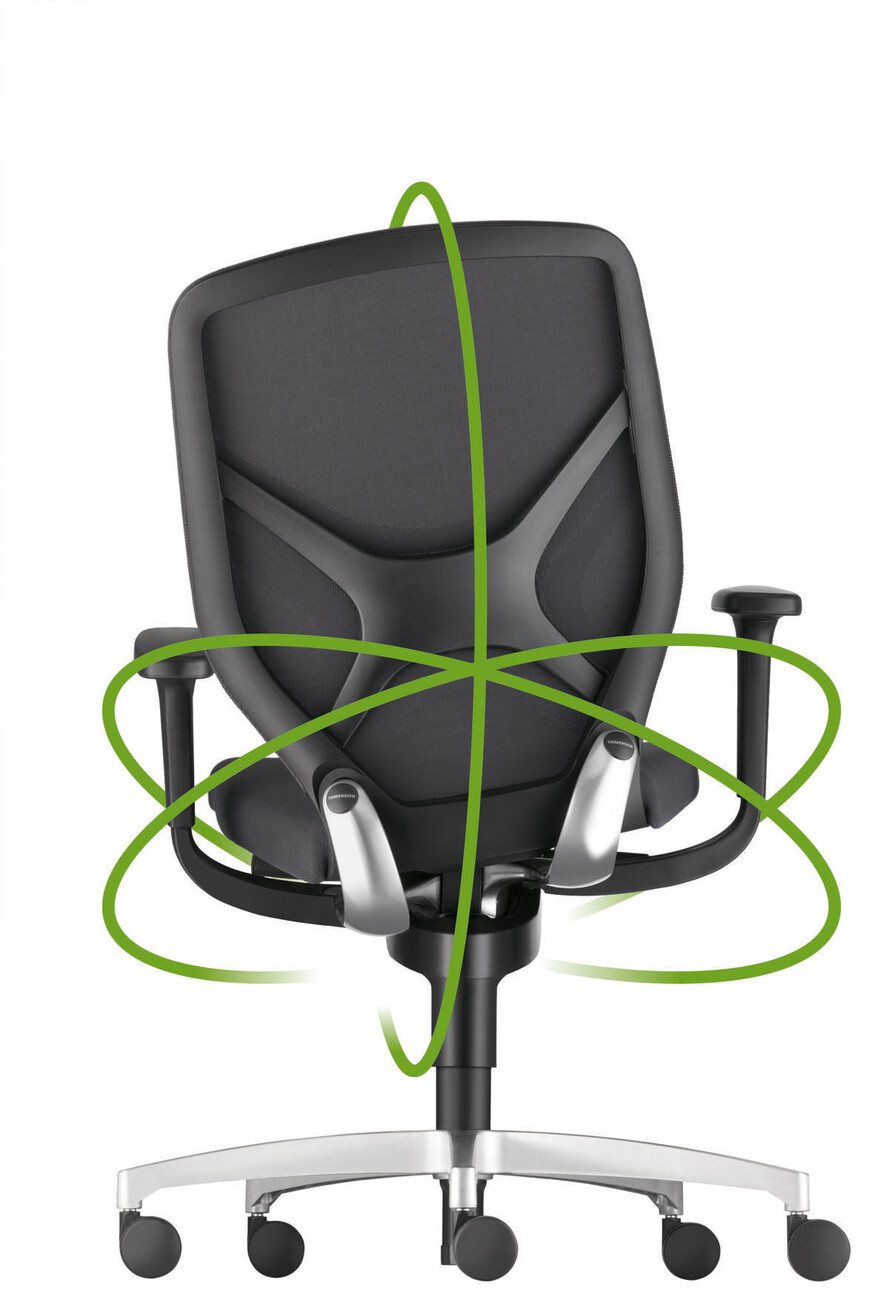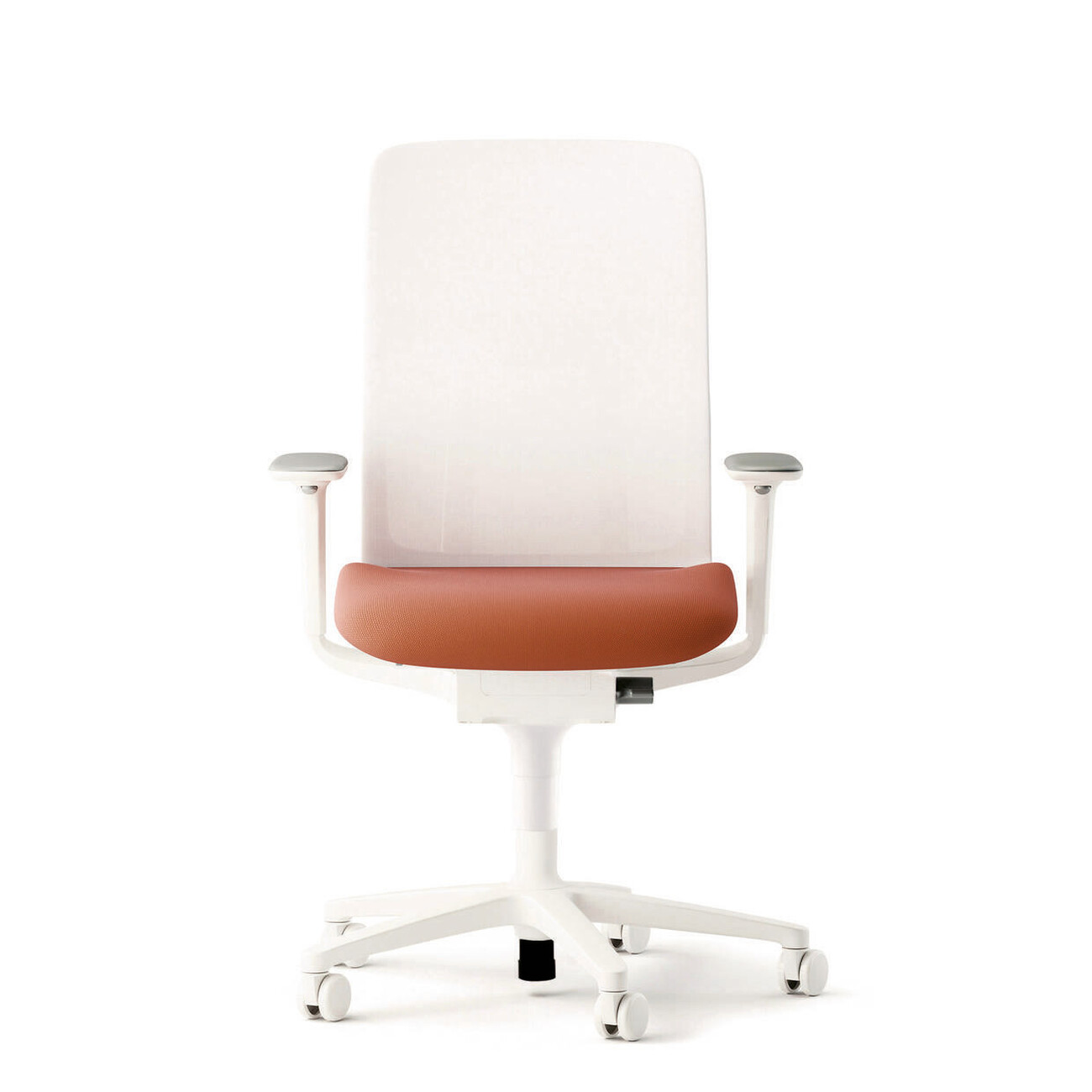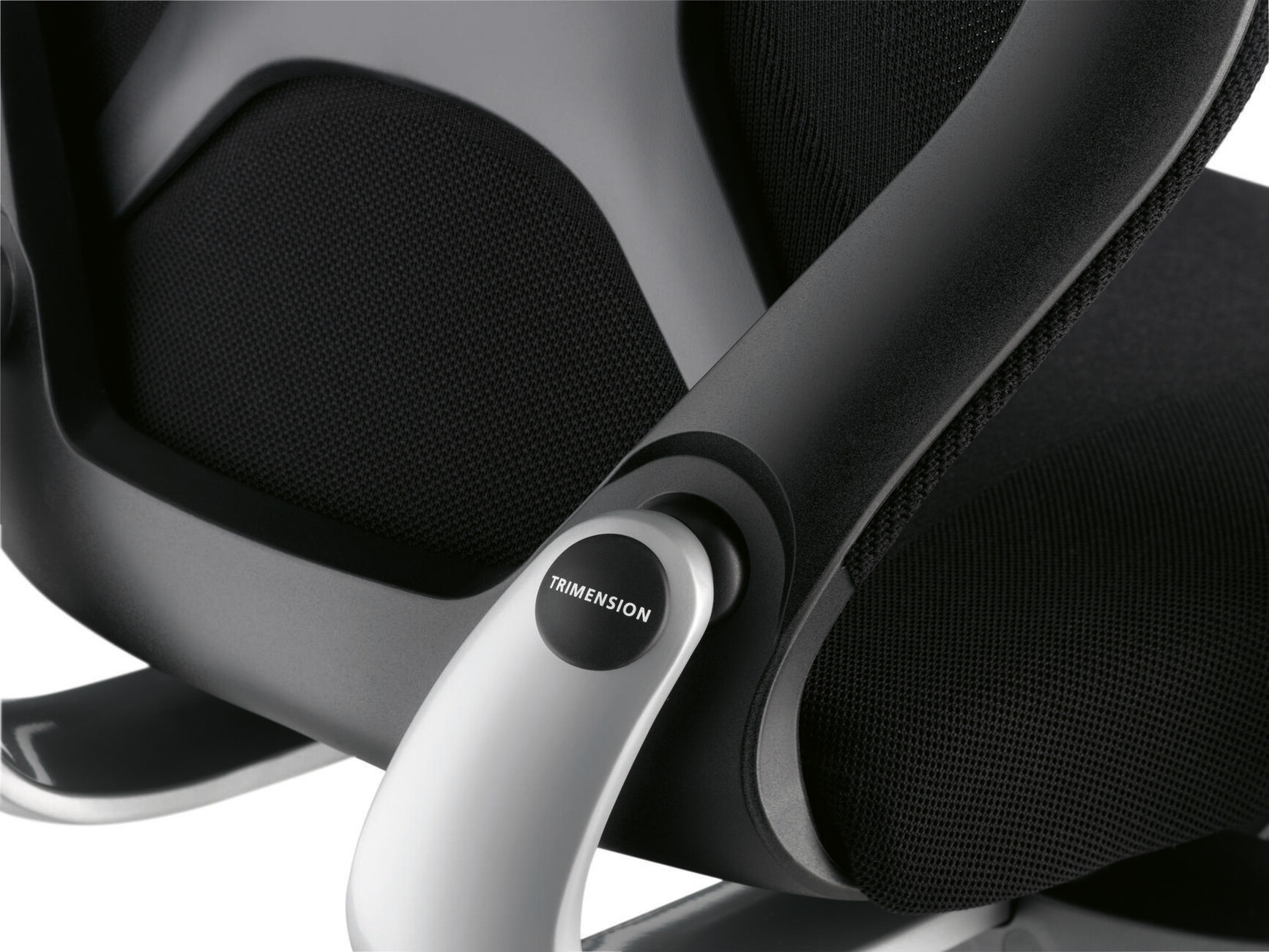Intuitive wellbeing
Anna Moldenhauer: What are the special features of developing a swivel chair with movement support in general?
Carsten Gehner: The focus is on finding a balance between agility and a sense of safety, as well as getting users moving in the workplace. Sitting still is the new smoking, so to speak. Changing posture has to happen intuitively via natural movement impulses, without having to think about it or be reminded. There is no intuitive movement on a sitting ball, for example, because sitting on it requires a high level of concentration. Our collaboration with Ingo Froböse, a specialist in prevention and rehabilitation, professor at the German Sport University Cologne and head of the Centre for Health, has provided us with many insights that are now being incorporated into our product development. The aim is to offer a design that is customised to the body and has a preventative effect against cramps and tension. Our Trimensions chairs offer a ‘body-similarity’ in the kinematic constellation, which means that the movements accompany the user in a body-orientated way.
How does the ‘Trimension’ three-dimensional mechanism from Wilkhahn work ?
Carsten Gehner: The mechanism mimics the structure of the body with two knee joints at the front and two hip joints at the back. You could say we ‘taught sitting to walk’. The aim at the time was to make the synchronised mechanism, which had previously allowed the chair to lean forwards and backwards and was an important milestone, three-dimensional. Basically, the degrees of freedom of the joints show what a well-functioning chair mechanism should look like. The ‘ON’ swivel chair was the first on the market with a mechanism that allows the right and left sides to move independently of each other - for a completely new dimension of dynamic sitting. The special feature is that the user does not need to make any additional adjustments. Users are used to adjusting the restoring force with the synchronised mechanism and this is still possible with ‘ON’ and ‘IN’, but with these Trimensions chairs it affects all movements that can be made on the chair - leaning backwards as well as sideways movements. They are cushioned evenly so that you are always in balance. Every slight shift in weight results in a supported movement that encourages dynamic muscle work.
Carsten Gehner: ‘ON’ is the representative chair that leaves nothing to be desired in terms of function and design thanks to the wide range of model and combination variants, for example with different upholstery options and backrest heights. In an international context, this ‘scalability’ is often used to represent hierarchies: ‘ON’ as a typical ‘armchair for bosses’. The ‘IN’ model is the ‘sporty’ one and, with regard to the alternation between agility and balance, for me the absolute benchmark in terms of dynamic seating. The synergy of direct drive, torsion-resistant high-tech seat back element and backrest cover made of moulded knit creates a remarkable dynamic and a high level of seating comfort. The ‘AT’ – our ‘Smarter’ – offers an equally high level of comfort, but the kinematics principle is slightly different here: the centre of rotation is positioned higher up, in the middle of the back and above the body's centre of gravity in the hips. The special seat tilt raises the back slightly and therefore virtually stands up with the person. AT is perfect for desk sharing as it is balanced with different users. There is no need to manually adjust the individual weight, it works automatically. As a ‘customisable’ product, ‘ME’ follows the modular principle that works for every project, no matter how diverse the requirements are. We have designed the product in such a way that all equipment options and functions can be combined. This enables a high degree of customisation, hence the name ‘ME’. The ‘Progressive Motion’ kinematics ensure mobilisation of the spine by tilting the back sideways while the seat is fixed.
What are the challenges in development?
Carsten Gehner: First and foremost, you have to think far ahead, because there are many influencing factors in the development of a swivel chair – whether in terms of standards, design or comfort. Even if the product is an everyday object, its structure is very complex. You have to know how the settings interact, which is why testing is an important aspect. This is also how we understand pre-development, including prototyping, seat testing and user surveys. Our colleagues are usually happy to help with this. In this phase, it is particularly important to take the time for product testing in order to achieve a perfect result in development.
Are you also in contact with medical professionals for your research?
Carsten Gehner: Prof. Froböse gave us a lot of support, especially in the initial phase, together with the Centre for Health at the Cologne Sports University. This was a good fit, as he comes from the field of prevention and, as an advisor to the WHO and the German government, brings a great deal of expertise to the table. For example, the degrees of freedom of movement were analysed. This also included field trials that were scientifically monitored with regard to increasing the ability to concentrate, preventive effects on the back and oxygen saturation in the lower back muscles. The studies can be viewed on our website.
Do you continue to use the word ergonomics in communication?
Carsten Gehner: Ergonomics actually means that a product is designed for people and is then orientated towards them. And that is still the maxim, of course. Where we differentiate ourselves is in the concept of postural ergonomics, which focuses on an idealised sitting posture that needs to be supported. Movement is much more important and the next sitting posture is always the best.
How do you recognise when the chair's mobility is perfect?
Carsten Gehner: Comfort must always be guaranteed. Movements must be made by shifting the centre of gravity. Balance is the benchmark and yardstick, in all directions. The feet should also have a secure footing and the seated person must remain in control. We utilise the possibilities of rotation in the back area, for example, and ensure that the person always retains a sense of security. Feeling comfortable in the chair is actually the prerequisite for using it intuitively.
You also find inspiration in sectors such as the sporting goods industry or the automotive industry – what do you look out for?
Carsten Gehner: One example: for the three-dimensional mobility in the back – as with ‘Progressive Motion’ in the ME – we were inspired by the agility and minimalist design of skateboard axles. We have translated the idea of an energy accumulator that progressively hardens the greater the deflection into our backrest. Regardless of the size and weight of the person, they are held securely.
What are you working on at the moment?
Carsten Gehner: In addition to dynamic seating, sustainability is a major area of work for Wilkhahn, because Wilkhahn not only produces swivel chairs, but also conference and workshop equipment. Overall, we offer product solutions that help us to work in a healthier and more motivated way, that strengthen communication within the team and that people enjoy spending time in the company's workspaces. In other words, sustainability, clarity and the promotion of communication for people working in the office and from home.
Can you explain what you mean by sustainability?
Carsten Gehner: This relates to several areas - from creative sustainability, which requires a timeless design, to a long service life and the proportion of recycled material and recyclability. It is also our task to constantly question the current status in order to optimise the products, for example with regard to the carbon footprint.
You have played a key role in shaping Wilkhahn's product development for 20 years - in the meantime, the world of work and technology has changed dramatically. What is particularly important in the development of swivel chairs today?
Carsten Gehner: That the users feel comfortable. A large proportion of sitting now takes place in the home office. Nevertheless, employers rarely take on the task of furnishing the workplace there. You only have to think about how many hours a day are spent sitting on an office chair. When buying a mattress, many people think long and hard about which one is best for their back health, but hardly at all when buying a swivel chair. We want to raise awareness of the positive effect of a good swivel chair on back health. In addition, the technology should be universal and swivel chairs should be designed to be as simple as possible so that they provide optimum support for people in their daily work. Whether in the office or at home.
Wilkhahn @ Orgatec
Hall 9, Stand A30 / C35
22 to 25 October 2024
Opening hours:
Tuesday to Friday: 9 am to 6 pm























